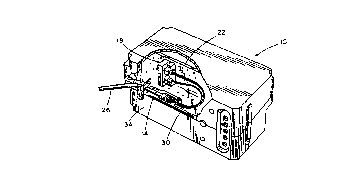Some of the information on this Web page has been provided by external sources. The Government of Canada is not responsible for the accuracy, reliability or currency of the information supplied by external sources. Users wishing to rely upon this information should consult directly with the source of the information. Content provided by external sources is not subject to official languages, privacy and accessibility requirements.
Any discrepancies in the text and image of the Claims and Abstract are due to differing posting times. Text of the Claims and Abstract are posted:
| (12) Patent: | (11) CA 2045489 |
|---|---|
| (54) English Title: | OPTICAL FIBER COUPLER |
| (54) French Title: | COUPLEUR DE FIBRES OPTIQUES |
| Status: | Expired and beyond the Period of Reversal |
| (51) International Patent Classification (IPC): |
|
|---|---|
| (72) Inventors : |
|
| (73) Owners : |
|
| (71) Applicants : |
|
| (74) Agent: | SMART & BIGGAR LP |
| (74) Associate agent: | |
| (45) Issued: | 1998-12-29 |
| (86) PCT Filing Date: | 1990-11-05 |
| (87) Open to Public Inspection: | 1991-05-10 |
| Examination requested: | 1997-11-04 |
| Availability of licence: | N/A |
| Dedicated to the Public: | N/A |
| (25) Language of filing: | English |
| Patent Cooperation Treaty (PCT): | Yes |
|---|---|
| (86) PCT Filing Number: | PCT/US1990/006380 |
| (87) International Publication Number: | US1990006380 |
| (85) National Entry: | 1991-07-02 |
| (30) Application Priority Data: | ||||||
|---|---|---|---|---|---|---|
|
An optical fiber coupler including an optical fiber
having an end, and an electronic light pulse communication
assembly comprising an assembly housing, an electronic light
pulse communication device fixed within the assembly housing,
and a lens mounted on the assembly housing and in light pulse
communication with the electronic light pulse communication
device. The optical fiber coupler also includes a coupler
housing having an inlet well, an assembly well separated from
the inlet well by a coupler housing well and having the
assembly fixedly received therein, and a fiber passage which
extends between the inlet well and the assembly well and which
snugly receives the fiber so that the fiber end is adjacent
the assembly lens. The coupler housing further includes epoxy
in the inlet well so that the fiber is secured to the coupler
housing, and index matching gel surrounding the optical fiber
end to assembly lens junction so that substantially all of the
light passing between the assembly lens and the fiber does not
escape from the optical fiber end to assembly lens junction.
Note: Claims are shown in the official language in which they were submitted.
Note: Descriptions are shown in the official language in which they were submitted.

2024-08-01:As part of the Next Generation Patents (NGP) transition, the Canadian Patents Database (CPD) now contains a more detailed Event History, which replicates the Event Log of our new back-office solution.
Please note that "Inactive:" events refers to events no longer in use in our new back-office solution.
For a clearer understanding of the status of the application/patent presented on this page, the site Disclaimer , as well as the definitions for Patent , Event History , Maintenance Fee and Payment History should be consulted.
| Description | Date |
|---|---|
| Inactive: IPC from MCD | 2006-03-11 |
| Time Limit for Reversal Expired | 2004-11-05 |
| Letter Sent | 2003-11-05 |
| Grant by Issuance | 1998-12-29 |
| Inactive: RFE acknowledged - Prior art enquiry | 1998-09-09 |
| Inactive: Final fee received | 1998-07-09 |
| Pre-grant | 1998-07-09 |
| Inactive: Correspondence - Prosecution | 1998-07-06 |
| Inactive: Correspondence - Prosecution | 1998-05-04 |
| Notice of Allowance is Issued | 1998-02-12 |
| Notice of Allowance is Issued | 1998-02-12 |
| Letter Sent | 1998-02-12 |
| Inactive: Application prosecuted on TS as of Log entry date | 1998-02-10 |
| Inactive: Status info is complete as of Log entry date | 1998-02-10 |
| Inactive: IPC assigned | 1998-01-02 |
| Inactive: IPC removed | 1998-01-02 |
| Inactive: First IPC assigned | 1998-01-02 |
| Inactive: Approved for allowance (AFA) | 1998-01-02 |
| Inactive: IPC assigned | 1998-01-02 |
| Inactive: IPC removed | 1998-01-02 |
| Request for Examination Requirements Determined Compliant | 1997-11-04 |
| All Requirements for Examination Determined Compliant | 1997-11-04 |
| Application Published (Open to Public Inspection) | 1991-05-10 |
There is no abandonment history.
The last payment was received on 1998-10-05
Note : If the full payment has not been received on or before the date indicated, a further fee may be required which may be one of the following
Patent fees are adjusted on the 1st of January every year. The amounts above are the current amounts if received by December 31 of the current year.
Please refer to the CIPO
Patent Fees
web page to see all current fee amounts.
| Fee Type | Anniversary Year | Due Date | Paid Date |
|---|---|---|---|
| MF (application, 7th anniv.) - standard | 07 | 1997-11-05 | 1997-10-01 |
| Request for examination - standard | 1997-11-04 | ||
| Final fee - standard | 1998-07-09 | ||
| MF (application, 8th anniv.) - standard | 08 | 1998-11-05 | 1998-10-05 |
| MF (patent, 9th anniv.) - standard | 1999-11-05 | 1999-10-04 | |
| MF (patent, 10th anniv.) - standard | 2000-11-06 | 2000-10-03 | |
| MF (patent, 11th anniv.) - standard | 2001-11-05 | 2001-10-05 | |
| MF (patent, 12th anniv.) - standard | 2002-11-05 | 2002-10-02 |
Note: Records showing the ownership history in alphabetical order.
| Current Owners on Record |
|---|
| SQUARE D COMPANY |
| Past Owners on Record |
|---|
| EDWIN RASBERRY NEWELL |